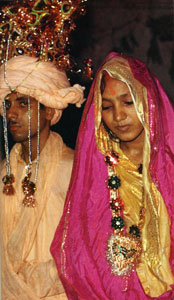
Barbara Bacon
bbacon@canterburyfortmyers.org
Canterbury School, Fort Myers, Florida
| HOME |
| LESSON 1 |
| LESSON 2 |
| LESSON 3 |
| LESSON 4 |
| RESOURCES |
LESSON 2 - HOW DO WE UNDERSTAND HINDUISM?
RATIONALE
Connecting to a student’s own experience can help clarify the sometimes inscrutable aspects of Hindu practice and belief.
PURPOSE
Students will have an enhanced understanding of the basics of Hinduism.
MATERIALS
Film "Understanding World Religions - What is Hinduism?" (This film shows Hindu adolescents explaining their basic beliefs in clear language and an enjoyable format.)
PROCEDURE
Have students consider the idea that there are moments in life that are memorable because of their deep, positive impact on us as individuals. These could be moments associated with a great achievement, an intense feeling of pride/patriotism/religious or personal enlightenment, etc. -- a moment when we are fully absorbed/aware of feeling deeply enriched.
Ask students to recall a time in their own lives when they may have experienced this kind of moment. Have them consider that this experience may be hard to explain to others but is not diminished because of that. This recognition may be a viable way to view Hinduism's beliefs and practices from our western attitudes and views.
Share all or part of this information from Stephen Huyler's book SEEKING GOD: "The concept of multiple deities can be overwhelming to an outsider. For the believer, the Absolute unmanifested Brahman has taken forms in order to govern specific aspects of existence and to provide direct and indisputable guidance to devotees. It is considered natural that as humans we respond to those deities that meet individual needs. Some, such as Shiva, are demanding of a rigorous and disciplined life. Rama, one of the ten incarnations of Vishnu, is a leader and warrior whose qualities are justness and social balance. Krishna, another of Vishnu's incarnations, is linked to the heart and to salvation through love. The Goddess Durga is the embodiment of the feminine power of action, invoked as a decisive force to bring about change by vanquishing evil and restoring peace. Lakshmi is the feminine provider of wealth and prosperity, prayed to for the health and welfare of the family. Ganesha, one of the sons of Shiva, is beseeched at the beginning of any endeavor to bring about its success." (Huyler, p. 32-33)
Show the film, stopping at various points to allow for students to react, answer questions, or do brief guided writing or drawing.
ASSOCIATED VISUALS
 |
"Indians see deep religious significance in their land. Trees, rocks, and waterfalls are often turned into sacred shrines after people find religious meaning in their presence. Villagers give thanks for the fertility of the soil through rituals and fesitvals in honor of the goddesses of fertility and prosperity. Mountains and forests provide scenes for the great struggles between divine and demonic forces." (Younger, p. 7) "Sacred trees are as varied as the communities they represent. Beneath this ancient tree, a large wooden sculpture is carved with multiple images of the Goddess Roopan Devi and with animals associated with her protection.: (Huyler, 102) |
 |
"Hindu weddings are festive occasions, sometimes lasting two or three days." (Younger, 72) |
 |
"The streets leading up to most temples are filled with shops and vendors' stalls that cater to the needs of the devotees: incense, camphor, flowers, and fruit to be offered in the sanctum; framed prints, images of deities, and the accoutrements for household worshp; clothes, footwear, oranments and healthcare items; tea, coffee, soft drinks, snacks, and meals." (Huyler, 116) |
 |
"The blare of trumpets and pounding of drums herald the arrival of processional images brought down to the plains from their temples in the high Himalayan villages." (Huyler, 158) |